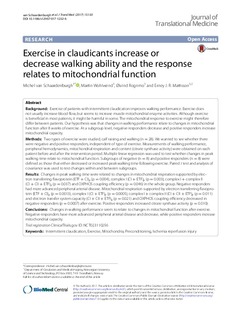| dc.contributor.author | van Schaardenburgh, Michel | |
| dc.contributor.author | Wohlwend, Martin Rainer | |
| dc.contributor.author | Rognmo, Øivind | |
| dc.contributor.author | Mattsson, Erney | |
| dc.date.accessioned | 2018-01-24T08:53:34Z | |
| dc.date.available | 2018-01-24T08:53:34Z | |
| dc.date.created | 2017-06-20T15:09:49Z | |
| dc.date.issued | 2017 | |
| dc.identifier.citation | Journal of Translational Medicine. 2017, 15 (130), . | nb_NO |
| dc.identifier.issn | 1479-5876 | |
| dc.identifier.uri | http://hdl.handle.net/11250/2479254 | |
| dc.description.abstract | Background
Exercise of patients with intermittent claudication improves walking performance. Exercise does not usually increase blood flow, but seems to increase muscle mitochondrial enzyme activities. Although exercise is beneficial in most patients, it might be harmful in some. The mitochondrial response to exercise might therefore differ between patients. Our hypothesis was that changes in walking performance relate to changes in mitochondrial function after 8 weeks of exercise. At a subgroup level, negative responders decrease and positive responders increase mitochondrial capacity.
Methods
Two types of exercise were studied, calf raising and walking (n = 28). We wanted to see whether there were negative and positive responders, independent of type of exercise. Measurements of walking performance, peripheral hemodynamics, mitochondrial respiration and content (citrate synthase activity) were obtained on each patient before and after the intervention period. Multiple linear regression was used to test whether changes in peak walking time relate to mitochondrial function. Subgroups of negative (n = 8) and positive responders (n = 8) were defined as those that either decreased or increased peak walking time following exercise. Paired t test and analysis of covariance was used to test changes within and between subgroups.
Results
Changes in peak walking time were related to changes in mitochondrial respiration supported by electron transferring flavoprotein (ETF + CI)P (p = 0.004), complex I (CI + ETF)P (p = 0.003), complex I + complex II (CI + CII + ETF)P (p = 0.037) and OXPHOS coupling efficiency (p = 0.046) in the whole group. Negative responders had more advanced peripheral arterial disease. Mitochondrial respiration supported by electron transferring flavoprotein (ETF + CI)P (p = 0.0013), complex I (CI + ETF)P (p = 0.0005), complex I + complex II (CI + CII + ETF)P (p = 0.011) and electron transfer system capacity (CI + CII + ETF)E (p = 0.021) and OXPHOS coupling efficiency decreased in negative responders (p = 0.0007) after exercise. Positive responders increased citrate synthase activity (p = 0.010).
Conclusions
Changes in walking performance seem to relate to changes in mitochondrial function after exercise. Negative responders have more advanced peripheral arterial disease and decrease, while positive responders increase mitochondrial capacity. | nb_NO |
| dc.language.iso | eng | nb_NO |
| dc.publisher | BioMed Central | nb_NO |
| dc.rights | Navngivelse 4.0 Internasjonal | * |
| dc.rights.uri | http://creativecommons.org/licenses/by/4.0/deed.no | * |
| dc.title | Exercise in claudicants increase or decrease walking ability and the response relates to mitochondrial function | nb_NO |
| dc.type | Journal article | nb_NO |
| dc.type | Peer reviewed | nb_NO |
| dc.description.version | publishedVersion | nb_NO |
| dc.source.pagenumber | 10 | nb_NO |
| dc.source.volume | 15 | nb_NO |
| dc.source.journal | Journal of Translational Medicine | nb_NO |
| dc.source.issue | 130 | nb_NO |
| dc.identifier.doi | 10.1186/s12967-017-1232-6 | |
| dc.identifier.cristin | 1477621 | |
| dc.description.localcode | © The Author(s) 2017. This article is distributed under the terms of the Creative Commons Attribution 4.0 International License (http://creativecommons.org/licenses/by/4.0/) | nb_NO |
| cristin.unitcode | 194,65,25,0 | |
| cristin.unitname | Institutt for sirkulasjon og bildediagnostikk | |
| cristin.ispublished | true | |
| cristin.fulltext | original | |
| cristin.qualitycode | 1 | |

